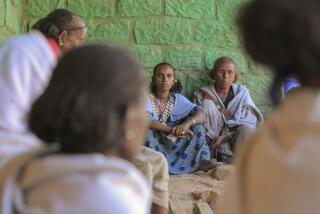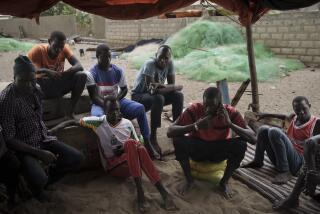9 Lean Years Bring Exodus, Starvation, Suicide : Even the Dogon, Mali’s Skilled Farmers, Can’t Evade Famine
- Share via
BANDIAGARA, Mali — Nine lean years have exacted a heavy toll on the Dogon, farmers of such skill that they steal topsoil back from the rivers to grow vegetables atop barren rock.
For the first time since they sought refuge on their remote, steep cliffs in northwestern Africa centuries ago, the Dogon are leaving in large numbers to look for food and work. And nomads from the north are moving in.
The trauma was so great last year, American researcher Sarah Brett-Smith found, that six or seven Dogon fathers hanged themselves each week over the shame of seeing their wives and children starve.
In one village, a woman watched her five young sons weaken from hunger and die of measles, one by one. Then she killed herself.
“I know of families where nine out of 10 sons have gone off to the cities,” Mitch Michaud, a Peace Corps forester from Maine, said. “They say once a Dogon goes, he does not come back.”
Forget Traditions in City
Some do return. But like other young Africans, many forget their traditions in the city. And the elders warn that it is tradition--the veneration of water, rock and spirits--that binds the Dogon.
“It is impossible to measure the impact of change,” said Noumou Diakite, director of livestock for the region. “But it is serious, very serious.”
The Dogon fled south from the Niger River when Fulani and Tuareg herders moved in on their lands. As a fortress and hiding place, they chose the jagged sandstone outcroppings of a 50-mile-long cliff face.
Dogons built 55 villages. Some sat on the edge of a precipice, with a spectacular view across the southern plain toward Burkina Faso. Others spilled vertically down the rocks at the cliff base.
Trails no wider than a goat wound down the cliff face. The Dogon dislodged the Telem, an ancient Pygmy-sized people, and used their dwellings in caves and hollows as burial sites.
The Dogon developed elaborate customs, mixing daily chores with spirit worship, padding along their remote paths in colorful robes and hats.
Women carried onions, tomatoes and beans to market in giant yellow gourds balanced on their heads.
The Dogon were known across Africa for the elaborate masks and dances of their fiercely protected culture, their tightly knit families and, especially, for their success at farming skills in severe conditions.
With little farmland, they created what amounts to gigantic flower pots in rocky depressions.
“They farm dirt,” Pierre-Olivier Henri, a Swiss geologist working here, said. “They scoop it up from riverbeds 100 yards, even 1,000 yards, away. They make a two-foot layer, mix it with humus and close it in with stones. It’s very productive.”
Dogon granaries, like mud-and-straw doll houses set rakishly on stilts, store millet for years, safe from bugs and rain. Their vegetables earned cash, which they held against emergencies.
Years of Drought
But now conditions in the Sahel, brought on by years of drought, are too tough even for the Dogon.
Malian authorities estimate that since 1984, 30,000 to 50,000 of the Dogon Plateau’s 165,000 inhabitants may have left. Brett-Smith estimated that the figure might be closer to 100,000.
Most go to richer land to the south, already overcrowded with other refugees, and cities as far away as Abidjan, capital of the Ivory Coast. Some send money home, and a few return at sowing time.
What little food the Dogon have left is partly appropriated by desperate Fulani and Tuareg, who have finally caught up with the Dogon.
The nomads, escaping even worse conditions in the desert to the north, find no land in Dogon country. And few can farm. Their last few animals eat crops and graze the dry, fragile land.
Brett-Smith said that at the last harvest, “every farmer found himself hamstrung with eight or 10 refugee women who refused to leave and insisted on helping. Farmers lost a tremendous portion to the helpers.”
The influx has upset a delicate balance between farmers and the herders, who once visited only briefly to trade animals for grain. But even without outsiders, Dogons say, life is an uphill fight.
Tegouro, situated on the broad plain between the Niger and a cliff, is one of the villages with farmland. But trees, cut for firewood, are fast disappearing. Erosion is turning the parched land to desert.
Irrigation Vital
“If we did not have this irrigation system, we would all be gone,” said Andouro Diguiba, chief of Tegouro village near the little mud town of Bandiagara, capital of Dogon country.
Local farmers dug canals, fed by a small river, and pumped in water to grow rice and vegetables. They are producing a meager crop, but they pray for rain to bring back water levels.
The underground tables are dropping too low for the Dogon well-digging equipment. The U.N. Children’s Fund and European volunteer agencies are helping, but the job is vast.
Dogons built 53 catchment dams, but 23 are useless. If rain falls at all, it comes in hard, fast torrents that wash away bridges, roads and dikes. Rivers can rise 16 feet in a few hours. And then they dry up.
‘Topsoil Is Going’
“Now there is a serious erosion problem,” Henri said. “The topsoil is going, and the land is not coming back.”
Apart from the drought, the Dogon have been struck by tourism.
Until the early 1980s, only a few hearty travelers penetrated Dogon country. Bandiagara is a hard hour from the Niger River port of Mopti. The cliff is three hours more up a teeth-rattling dirt track.
A good look requires days of hiking up and down the narrow trails carved onto the cliff face. In recent years, however, French, German and some American tourists have come in by the thousands.
No Hotels in Area
“Tourism brings revenue but not much remains here,” Sina Alou Thera, aide to the regional commander, said. There are no hotels, and transportation is paid for in Mopti or outside Mali.
The effect of tourism, however, is clear.
In any village, children besiege visitors, screaming what has become a common phrase in Dogon territory: “ Donne-moi un bic .” It means, “Give me a ballpoint pen.”
Often an enterprising youngster will add: “ . . . so I can study better at school.” Mostly, gift pens are used as currency. Children have found tourists more susceptible to giving ballpoints than money.
Masks Being Sold
Treasured Dogon masks and carvings are rarer here than in American and European private collections. Desperation has yielded the last remaining Dogon heirlooms, purchased by eager tourists.
At Songho village, large signs in French and English urge visitors to see ceremonial rock paintings more than a century old. To please tourists, however, the original artwork is repainted every three years with garish red pigment mixed in owl droppings.
Sanga, the last village before the cliffs, already has a reputation as the Coney Island of the Dogon Plateau, where hustling tourists has supplanted other local activities.
More to Read
Sign up for Essential California
The most important California stories and recommendations in your inbox every morning.
You may occasionally receive promotional content from the Los Angeles Times.













